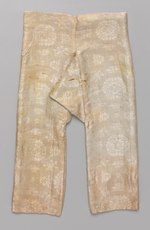| Ku | |||||||||||||||||
|---|---|---|---|---|---|---|---|---|---|---|---|---|---|---|---|---|---|
 A ku worn by a small boy, likely worn by a member of the imperial family or nobility, Tang dynasty | |||||||||||||||||
| Chinese name | |||||||||||||||||
| Traditional Chinese | 褲 | ||||||||||||||||
| Simplified Chinese | 裤 | ||||||||||||||||
| Literal meaning | Trousers/ pants | ||||||||||||||||
| |||||||||||||||||
| English name | |||||||||||||||||
| English | Trousers | ||||||||||||||||
Ku (Chinese: 褲; lit. 'trousers') or kuzi (Chinese: 褲子; lit. 'trousers/pants'), collectively refers to the traditional Chinese trousers in Hanfu in the broad sense. Ku can also refer to the kaidangku (Chinese: 開襠褲; pinyin: kāidāngkù; lit. 'Open crotch trousers'),[1][note 1] which are Chinese trousers without a rise as opposed to the trousers with a rise, referred as hedangku (Chinese: 合襠褲; pinyin: hédāngkù; lit. 'crotch trousers') or kun (Chinese: 褌; pinyin: kūn; lit. 'breeches/drawers') in ancient times.[note 2][2][3]
The upper garment yi, the ku which evolved from the jingyi which existed since the neolithic period, and the chang (Chinese: 裳; lit. 'skirt') from which the qun (Chinese: 裙; lit. 'skirt') eventually evolved from, are indigenous to Central area of China.[3] When the ku is combined with the yi upper garment and the chang, the complete attire in the Hanfu-system is formed.[3] The ku is worn as a lower garment in a set of attire known as shanku and/or sometimes be worn under the skirt of the ruqun.[3] With time, the Chinese trousers evolved and changed in a variety of shapes and styles.[2] The adoption of the hedangku used in the Hufu of Northern nomadic people through the adoption of the Hufuqishe policy by King Wuling of Zhao during the Warring States period eventually made the hedangku-style trousers popular among the ancestors of the Han Chinese and the Chinese ethnic minorities in the South.[2][3] The Hufu-style hedangku influenced the development of both the ku and kun of the Han Chinese and the hedangku of the other ethnic minorities of China leading to the creation and development of more innovative styles of trousers with time.[2] There are many different styles and shapes of hedangku which differ based on the ethnic groups of China; the shape and form of the rise structure in the hedangku also vary depending on different ethnic minorities.[2]
- ^ Cite error: The named reference
:5was invoked but never defined (see the help page). - ^ a b c d e Xie, Yong; Wu, Qiuying; Jiang, Ru; Qi, Yujie (2019). "云贵粤地区少数民族合裆裤的多元化构成" (PDF). Journal of Silk. 56 (3): 78–83. Archived from the original on 16 June 2022.
- ^ a b c d e Xu, Rui; Sparks, Diane (2011). "Symbolism and Evolution of Ku-form in Chinese Costume". Research Journal of Textile and Apparel. 15 (1): 11–21. doi:10.1108/rjta-15-01-2011-b002. ISSN 1560-6074.
Cite error: There are <ref group=note> tags on this page, but the references will not show without a {{reflist|group=note}} template (see the help page).